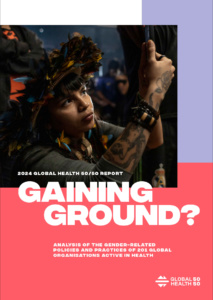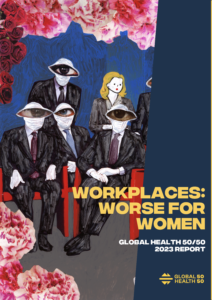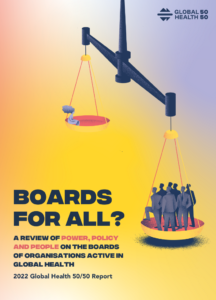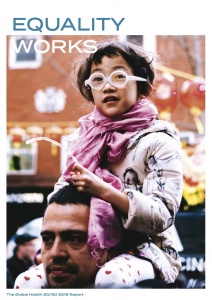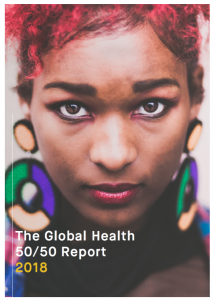The Global Report
Image: Alpha Woman I, Nifesah Mehru Nisa (Pakistan)
Through its flagship report and Gender and Health Index, Global Health 50/50 provides the only birds-eye view of gender and equality in the global health system today. The report reviews the gender-related policies and practices of 200+ organisations. These are global organisations (operational in more than three countries), that aim to promote health and/or influence global health policy. The sample covers organisations from 10 sectors, headquartered in 37 countries across seven regions and which, together, employ an estimated 4.5 million people. We insist on transparency that places organisation’s policies and practices under the spotlight to incentivise action and enable accountability.
Our Global Reports
2024
Gaining ground?
Global Health 50/50’s 2024 Report presents a detailed analysis of gender equality and diversity in global health leadership across 201 organisations active in global health. Read the report.
2023
Workplaces: Worse for women
Workplaces: worse for women, Global Health 50/50’s sixth annual Report, explores an area of policy that plays a decisive role in promoting equal opportunity in the workplace: the extent to which sexual and reproductive health and rights are recognised and addressed in workplace policies. Read the report.
2022
Boards for all?
The fifth annual Global Health 50/50 report presents our first-ever analysis of the gender and geography of who governs global health. Through an examination of the demographics of over 2,000 board members of the most influential organisations active in global health, the report warns that global health is not living up to its name. Read the report.
2021

Flying blind in times of crisis
The COVID-19 crisis has revealed deep inequalities in societies. The 2021 report examines whether a gendered response was taken to COVID-19 and the extent of progress on organisations’ commitments to gender equality and diversity. Read the Report.
2020

Power, privilege and priorities
The 2020 Report reviews 200 organisations and complements the seven core variables with a diversity lens, alongside an in-depth look at the priorities of the global health ecosystem. Read the report.
2019
Equality works
The 2019 Report reviewed 198 organisations across the core variables alongside an in-depth look at gender in the workplace, including sexual harassment policies, family-friendly and flexible working policies and gender pay gaps. Find the related How-To Guides here. Read the report.
2018
The Global Health 50/50 Report
The inaugural GH5050 report presented data on 140 organisations across seven core variables. Read the report.
Our variables assess policies and practice across three domains.
1) Workplaces that promote gender equality and diversity
To promote gender equality in health, organisations must first get their own houses in order. This means leadership which is diverse in gender and geography. It means policies which promote diversity and advance women’s careers, family-friendly workplaces that support caregivers and strive to achieve a work-life balance, and workplaces that are safe for all.
2) Addressing the role of gender in health outcomes and health inequities
Gender affects the health of all people: men, women, non-binary and transgender populations. To address this, organisations and funders must put gender at the heart of their work by ensuring that their policies, programmes and approaches are fully gender-responsive.
3) Shifting the discourse
For long-term change to happen, it must be accompanied by change in discourse and narratives. The resurgence of a political backlash against the the concept of ‘gender’ and the rise of interest groups who argue that gender is an “ideology”, or who deny that achieving gender equality means realising sexual and reproductive health and rights for all, has made definitions and commitments more important than ever. Organisations must step up to define what they mean by gender and publicly commit to promoting equality as a core priority.

